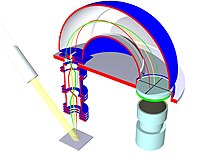Hemisphere analyzer

A hemisphere analyzer is a detector for high-resolution measurement of particle energies , especially electrons in photoelectron spectroscopy or Auger electron spectroscopy . An ideal hemisphere analyzer consists of two concentric electrodes between which an electrical voltage is applied. Depending on the voltage applied, only particles with a certain energy can pass the detector.
functionality
If the potentials or are applied to the inner or outer hemisphere, the electrical potential or the electrical field strength in the space between the electrodes is determined by the Laplace equation :
are and the radii of the hemispheres. From the condition that the electrons (or the negatively charged ions ) with the kinetic energy follow a circular path with a radius , it follows that the force effect due to the electric field is equal to the centripetal force ( ). This results in the condition for the potentials:
- ,
with the energy of the electrons in eV . This equation gives the potential difference between the two hemispheres:
- .
This equation determines the potential that must be applied to the electrodes so that electrons with the energy can cross the detector. This energy is called pass energy (Engl. Pass energy ), respectively.
The energy resolution of the detector depends on the geometrical parameters of the analyzer and the angular distribution of the incoming electrons.
- ,
with the aperture size and the angle of incidence of the electrons.
While a low pass energy improves the energy resolution, it reduces the number of electrons that pass the detector, so that the signal-to-noise ratio deteriorates and longer measurement times are necessary. The number of electrons allowed through is approximately proportional to the passenger energy. A disadvantage of the detector is that the probability that an electron will cross the detector depends on the original energy of the electron. The detector must be calibrated in order to compare the intensity of signals that are far apart. In front of the analyzer there are electrostatic lenses with two main functions: They collect and focus the incoming electrons on the entrance aperture of the analyzer and they decelerate the electrons so that lower pass energies with better resolution can be used.
In order to determine the energy spectrum of the impinging electrons, the pass energy ( i.e. and ) is normally kept at a constant value and the braking voltage of the electrostatic lenses is varied, this leads to a constant resolution in the entire energy range.
literature
- Hans Dietrich Polaschegg: Spherical analyzer with pre-retardation . In: Applied physics . tape 4 , no. 1 , June 1974, p. 63-68 , doi : 10.1007 / BF00884154 (in-depth article).
Web links
Individual evidence
- ^ D. Briggs, JT Grant: Surface Analysis by Auger and X-ray Photoelectron Spectroscopy. IM Publications LLP, 2003, ISBN 1-901019-04-7 .



![{\ displaystyle V (r) = - \ left [{\ frac {(V_ {2} -V_ {1})} {(R_ {2} -R_ {1})}} \ right] \ cdot {\ frac {(R_ {1} R_ {2})} {r}} + {\ text {const.}}}](https://wikimedia.org/api/rest_v1/media/math/render/svg/6d466e6f8ef1e80c967c0ce4ffb9ba1edf98d57e)
![{\ displaystyle | E (r) | = - \ left [{\ frac {(V_ {2} -V_ {1})} {(R_ {2} -R_ {1})}} \ right] \ cdot { \ frac {(R_ {1} R_ {2})} {r ^ {2}}}}](https://wikimedia.org/api/rest_v1/media/math/render/svg/75010d0e9e9852186e163276b2699841d3ae632c)











